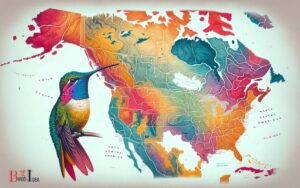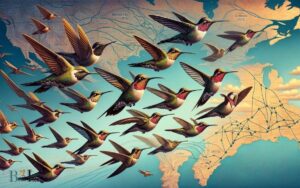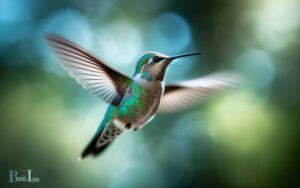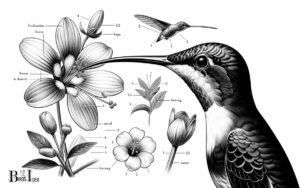What Type of Ecosystem Do Hummingbirds Live In: 10 Place
Hummingbirds live in a wide range of ecology types including tropical forests, sub-tropical scrublands, grasslands, and backyard gardens.
Hummingbirds are small, agile birds known for their rapid wing-flapping rates and the humming sound they produce.
Their preferred habitats are mainly in the Western Hemisphere, stretching from the southern part of Alaska to the southernmost tip of South America including the Caribbean.
These ecosystems are diverse and include rainforests, deciduous forests, coastal regions, deserts and mountainous regions up to altitudes of 14,000 feet.
The type of ecosystem affects the species of hummingbirds found in different locations.
Hummingbirds utilize a wide range of habitats from tropical forests, to scrublands, and even backyard gardens.
They are highly territorial creatures and have adapted to many different climates and can be found all over the world.
Their ecological needs consist of places with plenty of flowers for nectar and small insects to feed upon.
8 Hummingbird Species with Ecosystem
| Hummingbird Species | Ecosystem |
| Anna’s Hummingbird | Coastal Regions, Deserts |
| Rufous Hummingbird | Woodlands, Meadows |
| Black-chinned Hummingbird | Forests, Desserts |
| Ruby-throated Hummingbird | Deciduous Forests |
| Blue-throated Hummingbird | Mountain Forests |
| Costa’s Hummingbird | Desserts, Chaparrals |
| Broad-tailed Hummingbird | Meadows, Forests |
| Calliope Hummingbird | Mountainous Regions |
Key Takeaway
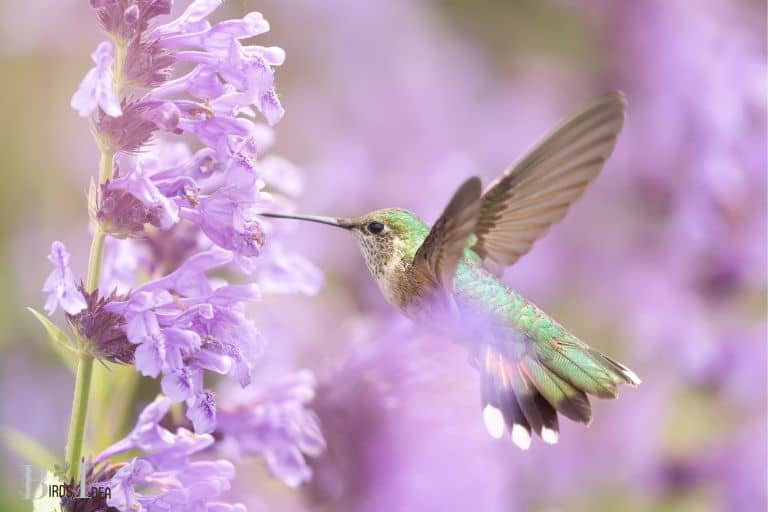
Five Facts About: Ecosystem Do Hummingbirds Live In
Here are the top 10 ecosystems in which hummingbirds are found:
1. Tropical Rainforests:

A tropical rainforest is an environment of high amounts of rainfall and warm temperatures with tall trees and many layers of vegetation. It is home to many species of animals, including hummingbirds.
2. Temperate Deciduous Forests:

Temperate deciduous forests are characterized by leafy trees that lose their leaves in the winter. These forests are common in temperate regions and they provide a habitat for some species of hummingbirds.
3. Chaparral:

Chaparral is an ecosystem of shrubs and other small vegetation adapted to dry and rocky soils in a Mediterranean climate. It provides a habitat for some species of hummingbirds.
4. Grasslands:

Grasslands are open areas of land mainly covered in grasses and low-growing vegetation, and it can be both natural or created by humans. Some species of hummingbirds live in grasslands.
5. Suburban and Urban Areas:

Suburban and urban areas are often characterized by expanses of concrete, and there are many hummingbird species that are adapted to life in an urban environment.
6. Mountains:

Mountains are regions of the Earth with large areas of high elevation and a distinct climate, topography, and ecology. Certain species of hummingbirds can be found living in mountains.
7. Deserts:

Deserts are arid and often hostile ecosystems of dunes and rocks, as well as cacti, shrub, and scrubland. Some species of hummingbirds inhabit the desert.
8. Gardens:

Gardens are small spaces, such as a park or lawn, that are designed and maintained to provide a habitat for plants, animals, and people. Hummingbirds commonly feed in gardens.
9. Parks:

Parks are public spaces that usually contain natural or built features, such as ponds, walking trails, and meadows, and they are often managed to conserve wildlife. Hummingbirds sometimes live in parks.
10. Agricultural Lands:

Agricultural lands are areas that are used for cropping and large-scale production of plants or animals. There are several species of hummingbirds that inhabit agricultural lands.
It’s worth noting that hummingbirds can be found in many other types of ecosystems as well, including tundra, savannas, and scrublands. They are highly adaptable birds and are able to thrive in a wide range of environments.
A bird can bring life to an entire ecosystem just by being there.
birdsidea
In Short : Ecosystem Hummingbirds Live In

Hummingbirds live in a variety of different habitats including tropical jungles and rain forests, grasslands, woodlands, semi-deserts, and wetlands. They also inhabit parks, gardens, and other urban areas.
The main factor in determining where hummingbirds live is the abundance of food sources and nesting locations.
Hummingbirds need to find an abundance of flower nectar, and other insects for nutrition, and for nesting locations, they require trees and shrubs with thick branches.
Over 340 different species of hummingbirds have been identified and can be found throughout the Americas from Canada to the southern tip of South America.
birdsidea
What Resources Does a Hummingbird Require?

Hummingbirds require a variety of resources to maintain their health and vitality. These include a suitable source of food and water, access to plants for shelter and nesting, and areas for bathing and to rest.
Some other resources that can be beneficial for hummingbirds are a nesting box, perches, and safe plants for roosting.
- Food: Hummingbirds feed on small insects, nectar from flowers, and small amounts of sugar water.
- Water: Hummingbirds need access to a clean source of water for drinking and bathing.
- Shelter: Plants provide important sources of shelter for hummingbirds as they roost, nest, and feed.
- Nesting Box: The addition of a nesting box can provide hummingbirds with a safe place to lay eggs and raise young.
- Perches: Provide hummingbirds with a convenient place to rest in between feeding or when roosting.
- Safe plants: Plant specific species of flowers and bushes that attract hummingbirds, such as columbines and honeysuckles.
- Bathing: A birdbath filled with clean water that is changed frequently will ensure hummingbirds have access to a suitable bathing area.
- Resting: Provide hummingbirds with suitable places to rest when they are not feeding or bathing. This could include a perch or a tree branch.
What Are the Common Species of Hummingbirds?

There are over 330 species of hummingbirds, including the Rufous, Anna’s, Allen’s, Broad-tailed, Ruby-throated, Calliope and Black-chinned hummingbirds.
Each species has its own unique characteristics, such as size, plumage, and call.
What Are the Migration Patterns of Hummingbirds?

Hummingbirds are migratory birds, with various species migrating at different times of the year.
Some northern species make short trips for shorter periods, while some species travel vast distances and remain away for longer periods.
How Have Hummingbird Populations Changed Over Time?

Hummingbirds are an iconic species found across much of the Americas. However, their populations have changed significantly over time.
These changes have been caused by a number of different factors, including climate change and environmental degradation.
Here are five major ways in which hummingbird populations have changed over time:
- Climatic Changes: Climate change has led to drastic changes in hummingbird habitats, affecting the local climate and weather patterns. This can affect the food sources and nesting areas that hummingbirds rely on.
- Human Activity: Human activity has had an immense impact on hummingbird populations. Agriculture and deforestation are two of the most significant threats to hummingbird habitats.
- Pesticides: The use of pesticides, which can contaminate hummingbird food sources, is a major factor in their population decline.
- Invasive species: Invasive species, such as rats and cats, can out-compete hummingbirds for food and habitat.
- Disease: A number of different diseases can affect hummingbird populations. Diseases like avian pox can spread quickly among hummingbird populations, resulting in catastrophic declines.
What Are the Effects of Human Activity on Hummingbirds?

Hummingbirds are greatly impacted by human activities. Habitat destruction and climate change are among the biggest threats to their survival.
Other effects include destruction of their food sources, destruction of their nesting areas, increase in competition, and accidental poisoning or injury.
The five main effects of human activity on hummingbirds are:
- Destruction of natural habitats: Much of the land that once held hummingbirds’ habitats has been converted to human use, forcing them to seek new homes elsewhere.
- Climate change: Rising temperatures, extreme weather patterns, and drought can all affect the availability of food sources, nesting areas, and other resources needed for hummingbirds to survive.
- Destruction of their food sources: Many of the flowers and insects that hummingbirds rely on for food are at risk due to pesticide use, climate change, and other factors.
- Destruction of their nesting areas: Human activities have caused deforestation and fragmentation of habitats, reducing the availability of safe nesting sites for hummingbirds.
- Increase in competition: As hummingbird numbers dwindle, other species – like sparrows and crows – are now competing for the same resources, presenting an additional threat to their survival.
- Accidental poisoning or injury: Hummingbirds can be vulnerable to accidentally ingesting poisons or getting caught in traps set out for other birds.
FAQ of What Type Of Ecosystem Do Hummingbirds Live In
What type of ecosystems do hummingbirds inhabit?
What are some of the features of a hummingbird’s habitat?
How much space does a hummingbird need to live?
How do hummingbirds adapt to different climates?
Are there different types of hummingbirds?
Conclusion
Hummingbirds need a variety of ecosystems to survive and thrive, withnbsp;tropical rainforests, deciduous forests and deserts providing the necessary mix of plants, insects, water sources and nesting sites.
Trees, shrubs and flowers are all essential elements in a hummingbird-friendly ecosystem, as they offer a source of food and shelter.

